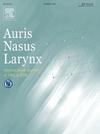A questionnaire survey for an orbital blowout fracture medical examination by Japanese otorhinolaryngologists
IF 1.5
4区 医学
Q2 OTORHINOLARYNGOLOGY
引用次数: 0
Abstract
Objective
The status of orbital blowout fracture (BOF) management remains unclear due to the lack of standardized guidelines and limited data from individual facilities. Therefore, the present study aimed to assess current practices for diagnosing, treating, and evaluating BOF among Japanese otorhinolaryngologists.
Methods
A web-based questionnaire was distributed to 1,800 members of the Japanese Rhinologic Society and 621 designated clinical training hospitals. The survey was conducted between May 23 and August 31, 2024, and gathered information on diagnostic procedures, treatment approaches, post-operative evaluations, and complications associated with BOF surgery. Responses from 318 facilities, excluding duplicates, were analyzed.
Results
Out of 318 facilities, BOF surgery was performed in 129 by otolaryngologists. Computed tomography (CT) was the primary diagnostic modality used pre-operatively at all facilities, with Hess screen tests also being widely used (82.1 %). However, post-operative CT usage was significantly lower (55.8 %). Surgical indications were often decided within 1–2 weeks post-injury in most facilities. The most common complication was infra-orbital nerve disorder (19.4 %), followed by nasal bleeding (10.1 %) and anterior superior alveolar nerve disorder (9.3 %). An endoscopic endonasal approach was commonly performed for medial wall fractures, while a combined intra-/extra-nasal technique was frequently conducted for inferior wall fractures. Rigid reconstruction was performed on approximately 50 % of cases, using materials such as absorbable plates and autologous bone.
Conclusion
The present study highlighted significant variations in BOF management among facilities, indicating the need for standardization in evaluation methods and post-operative follow-up.
日本耳鼻喉科医师对一例眼眶爆裂骨折医学检查的问卷调查
目的由于缺乏标准化的指南和个别机构的有限数据,眼眶爆裂骨折(BOF)的治疗状况尚不清楚。因此,本研究旨在评估目前日本耳鼻喉科医生诊断、治疗和评估BOF的做法。方法对1800名日本鼻科学学会会员和621家指定临床培训医院进行网络问卷调查。该调查于2024年5月23日至8月31日进行,收集了与BOF手术相关的诊断程序、治疗方法、术后评估和并发症的信息。分析了318家工厂(不包括重复工厂)的回复。结果318家医院中有129家由耳鼻喉科医师进行BOF手术。计算机断层扫描(CT)是所有机构术前使用的主要诊断方式,Hess筛查也被广泛使用(82.1%)。然而,术后CT使用率明显较低(55.8%)。在大多数机构中,手术指征通常在受伤后1-2周内确定。最常见的并发症是眶下神经紊乱(19.4%),其次是鼻出血(10.1%)和前上牙槽神经紊乱(9.3%)。内窥镜鼻内入路常用于治疗内侧壁骨折,而鼻内/鼻外联合技术常用于治疗下侧壁骨折。使用可吸收钢板和自体骨等材料对大约50%的病例进行刚性重建。结论不同医疗机构BOF管理存在显著差异,需要在评估方法和术后随访方面进行标准化。
本文章由计算机程序翻译,如有差异,请以英文原文为准。
求助全文
约1分钟内获得全文
求助全文
来源期刊

Auris Nasus Larynx
医学-耳鼻喉科学
CiteScore
3.40
自引率
5.90%
发文量
169
审稿时长
30 days
期刊介绍:
The international journal Auris Nasus Larynx provides the opportunity for rapid, carefully reviewed publications concerning the fundamental and clinical aspects of otorhinolaryngology and related fields. This includes otology, neurotology, bronchoesophagology, laryngology, rhinology, allergology, head and neck medicine and oncologic surgery, maxillofacial and plastic surgery, audiology, speech science.
Original papers, short communications and original case reports can be submitted. Reviews on recent developments are invited regularly and Letters to the Editor commenting on papers or any aspect of Auris Nasus Larynx are welcomed.
Founded in 1973 and previously published by the Society for Promotion of International Otorhinolaryngology, the journal is now the official English-language journal of the Oto-Rhino-Laryngological Society of Japan, Inc. The aim of its new international Editorial Board is to make Auris Nasus Larynx an international forum for high quality research and clinical sciences.
 求助内容:
求助内容: 应助结果提醒方式:
应助结果提醒方式:


